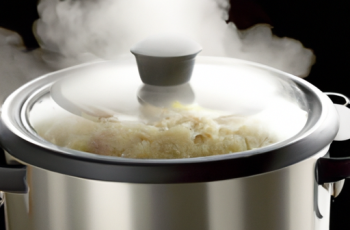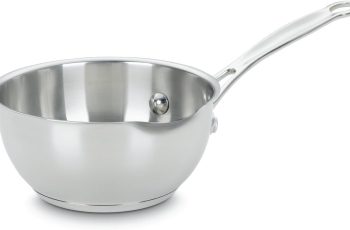Ad Blocker Detected
Our website is made possible by displaying online advertisements to our visitors. Please consider supporting us by disabling your ad blocker.
In this article, you will learn the essential steps for properly seasoning and maintaining a cast iron Dutch oven. The process of seasoning plays a crucial role in ensuring the longevity and non-stick properties of your Dutch oven, while proper maintenance is necessary to preserve its quality and prolong its lifespan. By following these expert guidelines and incorporating them into your cooking routine, you will be able to unlock the full potential of your cast iron Dutch oven and enjoy delicious meals for years to come.
Seasoning
Choosing the right oil
When it comes to seasoning a cast iron Dutch oven, choosing the right oil is crucial. The oil you select should have a high smoke point, as seasoning requires high temperatures. Some commonly used oils for seasoning include vegetable oil, canola oil, and flaxseed oil. Avoid oils with low smoke points, such as olive oil, as they can burn and create a sticky residue.
Preparing the Dutch oven
Before seasoning your Dutch oven, it’s important to ensure it is clean and free from any dirt or debris. Start by washing it with warm water and mild soap, using a sponge or dishcloth to gently scrub away any residue. Rinse it thoroughly and dry it completely to prevent moisture from causing rust.
Applying the first layer of oil
To season your Dutch oven, start by applying a thin layer of oil to the entire surface, including the lid and handle. Use a clean cloth or paper towel to evenly coat the cast iron with oil. Make sure to cover all the nooks and crannies, as this will help prevent food from sticking to the surface when cooking.
Baking the Dutch oven
After applying the first layer of oil, it’s time to bake the Dutch oven. Preheat your oven to a moderately high temperature, around 375-400 degrees Fahrenheit. Place the Dutch oven upside down on the middle rack and place a baking sheet or aluminum foil on the bottom rack to catch any drips. Bake the Dutch oven for about one hour to allow the oil to polymerize and create a smooth, non-stick surface.
Applying additional layers
To achieve a well-seasoned Dutch oven, it is recommended to repeat the oil application and baking process several times. This will help build up a stronger seasoning layer and enhance the performance of your Dutch oven. After each layer, allow the Dutch oven to cool before applying the next coat of oil. Aim for at least three to five layers, although some seasoned chefs swear by a dozen or more layers for the best results.
Cleaning
Avoiding harsh chemicals
When it comes to cleaning your cast iron Dutch oven, it’s best to avoid harsh chemicals. Strong detergents and abrasive cleaners can strip away the seasoning and damage the cast iron. Instead, opt for gentle, natural cleaning methods to preserve the integrity of your Dutch oven.
Removing food residues
Before cleaning your Dutch oven, remove any food residues or stuck-on bits. To do this, fill the pot with warm water and let it soak for a while to loosen the debris. Then, use a wooden or silicone spatula to gently scrape away the remaining food particles. Avoid using metal utensils or scouring pads, as they can scratch the surface of the cast iron.
Scrubbing with salt
To tackle stubborn stains or residues, try scrubbing the Dutch oven with salt. Sprinkle a generous amount of coarse salt onto the surface and use a sponge or cloth to scrub it in circular motions. The salt acts as a gentle abrasive that helps lift away the stubborn grime without damaging the seasoning.
Using a nylon brush
For tougher cleaning tasks, a nylon brush can be used. Make sure to choose a brush specifically designed for use on cast iron, as it will have stiff bristles that can effectively remove stuck-on food without scratching the surface. Gently scrub the Dutch oven in a circular motion, targeting any areas with stubborn residue.
Drying thoroughly
After cleaning your Dutch oven, it’s crucial to dry it thoroughly to prevent rusting. Use a clean towel to remove any excess moisture, and then place the Dutch oven on a stovetop or in a warm oven (set at a low temperature) to evaporate any remaining water. Make sure the Dutch oven is completely dry before storing it to avoid moisture-related issues.

Storing
Removing excess oil
Before storing your cast iron Dutch oven, it’s important to remove any excess oil. Use a clean cloth or paper towel to gently wipe away any leftover oil from the surface. Leaving excess oil can lead to rancidity and a sticky residue, which can affect the performance of the Dutch oven and make it harder to clean in the future.
Covering the Dutch oven
To protect your Dutch oven from dust and moisture, it’s a good idea to cover it when not in use. You can use the Dutch oven’s lid or invest in a fitted lid or silicone cover specifically designed for cast iron cookware. Covering the Dutch oven will also help prevent any unwanted odors or flavors from being absorbed.
Protecting against rust
To protect your cast iron Dutch oven from rust, it’s essential to keep it dry and avoid exposing it to moisture. Even a small amount of water can cause rust to form on the surface. If you come across any signs of rust, follow the restoration process outlined later in this article to restore your Dutch oven to its former glory.
Choosing an appropriate storage location
When it comes to storing your cast iron Dutch oven, choose a location that is cool, dry, and well-ventilated. Avoid storing it in a damp or humid environment, such as under the sink or in a basement, as these conditions can promote rust formation. If space allows, consider storing the Dutch oven on a shelf or in a cabinet with plenty of airflow.
Periodic maintenance
Even with proper storage, it’s essential to perform periodic maintenance on your cast iron Dutch oven. This includes checking for any signs of rust, re-seasoning if necessary, and ensuring it remains clean and dry. By staying on top of maintenance, you can extend the lifespan of your Dutch oven and ensure it continues to provide excellent cooking results.
Cooking Tips
Preheating the Dutch oven
Before starting to cook with your cast iron Dutch oven, it’s crucial to preheat it properly. Preheating the pot allows it to evenly distribute heat, ensuring your food cooks consistently. Place the Dutch oven on a stovetop or in the oven and heat it gradually over medium-low heat or a low oven temperature for several minutes.
Avoiding excessive heat
Cast iron is known for its excellent heat retention, so it’s important to avoid using excessive heat when cooking with a Dutch oven. High heat can cause the food to stick and burn, making it harder to clean the pot afterward. Instead, opt for medium or low heat settings and allow the Dutch oven to gradually heat up.
Adding oil or fat before cooking
To further enhance the non-stick properties of your Dutch oven, it’s recommended to add a small amount of oil or fat before cooking. This can help prevent food from sticking to the surface and make cleanup easier. Simply pour a small amount of oil or melt a small piece of butter in the Dutch oven before adding your ingredients.
Using wooden or silicone utensils
When cooking with a cast iron Dutch oven, it’s best to use wooden or silicone utensils. Metal utensils can scratch the seasoning and expose the cast iron to moisture, which can lead to rust formation. Wooden or silicone utensils are gentle on the surface and won’t damage the non-stick layer.
Avoiding acidic foods
Acidic foods, such as tomatoes or citrus fruits, can react with the cast iron’s surface and potentially leach iron into the food. While small amounts of iron are generally safe, it’s recommended to avoid cooking highly acidic or alkaline foods in a cast iron Dutch oven on a regular basis. Opt for stainless steel or enamel-coated cookware for acidic dishes.

Restoring Rusty Dutch Ovens
Removing rust
If your cast iron Dutch oven develops rust, don’t panic. Rust is treatable and can be removed with a few simple steps. Start by scrubbing the rusted area with a nylon brush or steel wool to remove the loose rust particles. Then, create a paste by mixing equal parts baking soda and water. Apply the paste to the rusted area and scrub it in a circular motion until the rust is gone. Rinse the Dutch oven thoroughly and dry it completely to prevent further rust formation.
Re-seasoning the Dutch oven
After removing the rust, it’s crucial to re-season your Dutch oven to restore its non-stick properties. Follow the seasoning process outlined earlier in this article, applying several layers of oil and baking the Dutch oven to polymerize the oil. Repeating this process will create a new seasoning layer and protect the cast iron from further rusting.
Regular maintenance to prevent rust
To prevent your Dutch oven from developing rust in the future, it’s essential to practice regular maintenance. Ensure the Dutch oven is properly cleaned and dried after each use, removing any residual food or moisture. If storing the Dutch oven for an extended period, consider applying a thin layer of oil to protect the surface from humidity. By maintaining a well-seasoned and rust-free Dutch oven, you can enjoy its cooking benefits for years to come.

